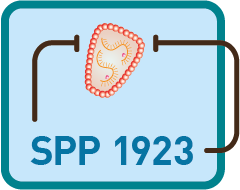Capsid-dependent innate sensing and restriction of retroviral replication complexes


Project Member

Prof. Dr. Hans-Georg Kräusslich
Project Leader
Prof. Dr. Hans-Georg Kräusslich
Phone: +49 6221 56 – 5001
Fax: +49 6221 56 – 5003
Hans-Georg.Kraeusslich@med.uni-heidelberg.de
Department of Infectious Diseases
Virology
University Hospital Heidelberg
Im Neuenheimer Feld 344
69120 Heidelberg
Germany

Tamara Naumoska,
PhD Student
Project Summary
The main objective of the proposed project is to elucidate the differential role of intact retroviral capsids regarding formation and nuclear entry of functional replication complexes with concomitant evasion from innate sensing of the viral nucleic acids. These studies will focus on HIV‑1 and MLV since these two viruses exhibit fundamental differences in the relevant functions, and functional chimera can be constructed. Within SPP1923, we will provide our method for analyzing productive replication complexes to other groups interested; depending on results, this may lead to analysis of further retroviruses in collaboration. Specifically, the proposed project has the following aims: I. Comparative characterization of infection, productive replication complex formation, nuclear targeting and innate sensing for HIV‑1 (and capsid stability mutants thereof), MLV and chimeric HIV- 1/MLV variants in different cell types. II. Isolation of bona fide replication complexes from the cytoplasm of (some of) these infections by established and novel methodology followed by proteomic characterization and analysis of their capacity to induce innate DNA sensing. III. Analysis of the association of retroviral replication complexes with known and presumed host factors and nucleic acid sensing molecules in the cytoplasm of different host cells infected with the relevant retroviral variants and applying imaging analysis, proximity biotinylation assays and targeted disruption of the viral capsid.

